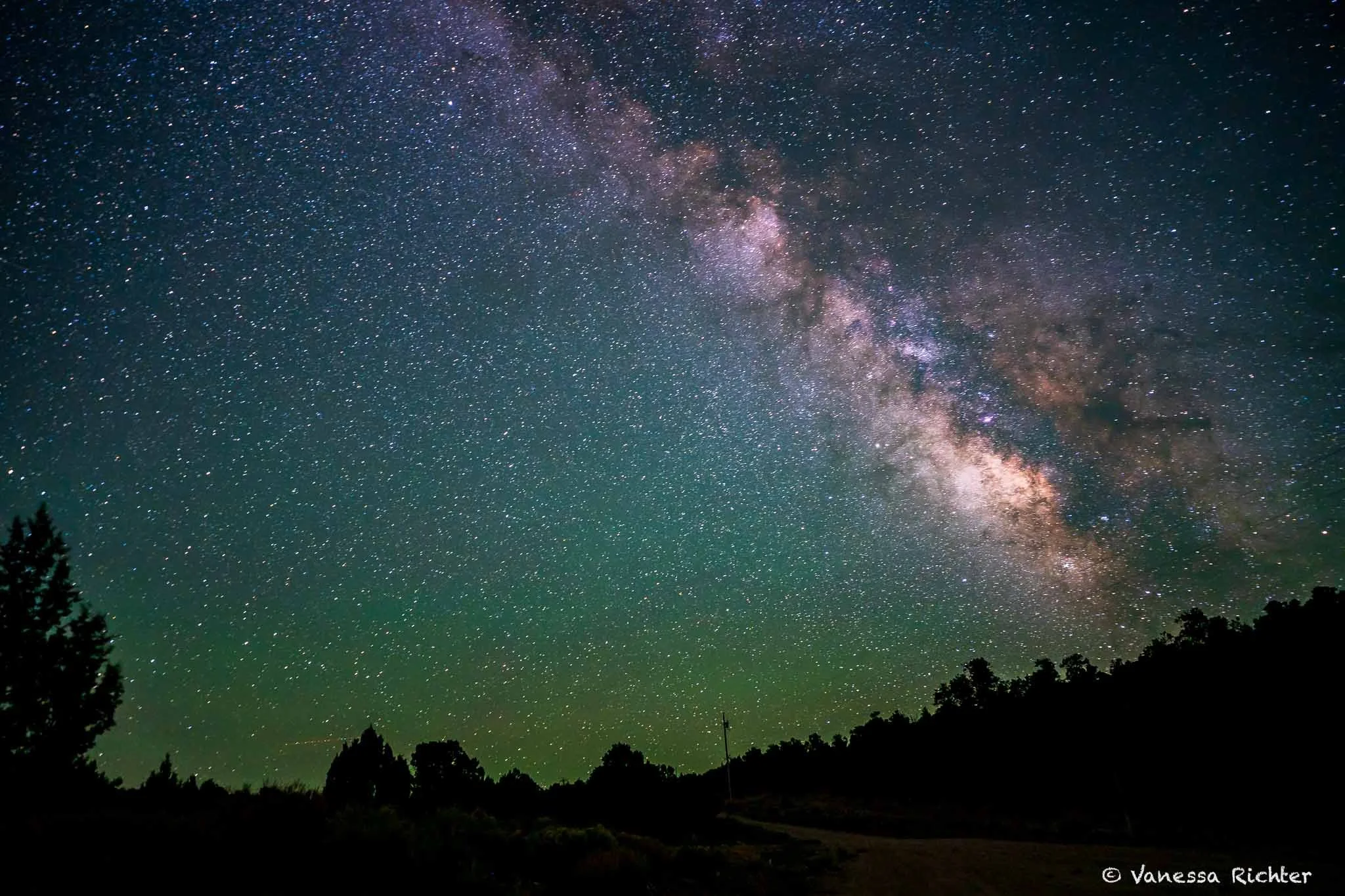Milky Way Photography Guide for the Western US: When, Where, Camera Settings & Gear Tips
I feel a tinge of fear in my bones as I step outside the little cabin. It is still warm, and it smells like desert sand, cooling down from the heat of the day. It is pitch dark, and even though I tried my best to avoid turning on the lights, I had briefly turned them on while moving from the bedroom to the front door. Now my eyes are adjusting to the darkness, and the longer I stand in the quietness of the night, the more I can see. More and more stars appear to my vision. They are countless and feel like millions of sparkling diamonds overhead. And there is something else: a whitish dust cloud-like shape hovers diagonally above the horizon, and its form is becoming clearer and clearer.
The Milky Way captured after moonset near Great Basin National Park in Nevada. Shot with a 20mm full-frame lens. Settings: ISO 1000, f/1.8, 30 seconds.
Observing the sparkling stars in the night sky at a truly dark place is an awe-inspiring experience. Most of us don’t have access to such dark night skies right outside our doors, but there are still many places in the world where one can gaze into a star-filled sky, with the Milky Way offering a glimpse into the beauty of the universe. If you’re ready to gaze up at a sky bursting with stars and capture the magic through your lens, you’re in exactly the right place!
In this article, I will cover everything you need to know to capture a great shot of our home galaxy. I’ll discuss the essential gear you’ll need to begin with, when and where to venture out to photograph it, and how to set up your camera to take a good shot once you have all your gear, the right place, and the right time.
Let’s dive in, shall we?
In a Nutshell: The Milky Way
What is a Galaxy?
Galaxies are vast systems consisting of stars, planets, and immense clouds of gas and dust, all held together by gravity. The largest galaxies can contain trillions of stars and stretch over a million light-years across. These celestial formations come in various shapes, primarily spirals and ellipticals, but also include irregular galaxies with less defined structures.
Most galaxies are ancient, ranging from 10 billion to 13.6 billion years old — i.e. some are nearly as old as the 13.8 billion-year-old universe itself! The youngest known galaxy emerged about 500 million years ago.
What Exactly Is the Milky Way?
The Milky Way is the galaxy where Earth resides — a spiral galaxy with a star-filled disk spanning over 100,000 light-years. Earth is located on one of its spiral arms, approximately halfway from the center. Just as Earth orbits the Sun, our solar system orbits the center of the Milky Way, completing an orbit roughly every 240 million years.
Hence, our view of the Milky Way is a glimpse from within the galaxy itself: when viewed from Earth, the central disk of our home galaxy appears as a faint, milky band of light stretching across the sky, which gives it its name.
The Milky Way is part of a local group of over 50 galaxies. These range in size from dwarf galaxies, containing up to a few billion stars, to the Andromeda Galaxy, our nearest large galactic neighbor.
Read more about galaxies and the Milky Way on NASA’s website.
How to Capture the Milky Way
Gear
First of all, let’s start with the gear you’ll need to capture the Milky Way in its full glory. There are three essential items you’ll need:
A Camera that allows you to shoot in fully manual mode.
Ideally, a full-frame camera, as these allow you to capture much more light and produce less noisy pictures, from which you can recover a lot of information from the raw images.
A Wide-Angle Lens Allowing For A Wide Open Aperture: The wide-angle lens will help in capturing the vastness of the Milky Way, and potentially an interesting landscape in the foreground.
Ideally, your wide-angle lens should be very light-sensitive, allowing for an aperture of f/2.8 or even wider.
A Sturdy Tripod: This will allow you to take long exposures.
In addition to these essentials, a few other items can be extremely useful:
A Red Light: As long as your eyes aren’t fully adapted to the dark, or if you get scared in the pitch dark, you may want to use a red light source to see your surroundings or camera settings. Red light is preferable because it won’t jeopardize your night vision.
A Stargazing App: An app with augmented reality view can help you figure out where exactly the Milky Way and other celestial objects are located. Such apps allow you to point your phone at the sky and see where stars, planets, and the Milky Way are.
Gloves: If you are shooting in cold conditions, gloves can be extremely helpful. Fingers can get freezing cold quickly if they’re constantly exposed to the cold air while you’re adjusting your camera position and settings. Gloves can help extend your shooting session comfortably.
📌 Pin for later
Where
In our world, dark skies have become a rare phenomenon, and only few people are lucky enough to live under truly dark night skies. Cities brighten up the skies for a large radius around them. Luckily, there are still many places in the world where you can find truly dark skies and get a peek into the massive universe around us.
So — How do you find places with no or very little light pollution?
Fortunately, there is a non-profit organization that concerns itself with dark skies and has the International Dark Sky Places (IDSP) program in place. This program “certifies communities, parks, and protected areas around the world that preserve and protect dark sites through responsible lighting policies and public education.” DarkSky International, formerly the International Dark-Sky Association (IDA), is based in the United States and certifies dark sky places worldwide. It was incorporated in 1988 by David Crawford, a professional astronomer, and Tim Hunter, a physician and amateur astronomer.
International Dark Sky Places by the IDA
There are currently five types of designation for International Dark Sky Places by the IDA: International Dark Sky Sancturies, Parks, Reserves, Communities and Places.
International Dark Sky Sanctuaries
The most remote (and often darkest) places in the world, whose conservation state is most fragile.
Eastern Lake County, regionally referred to as the “Oregon Outback” (southeastern Oregon)
The Lost Trail National Wildlife Refuge, located in Pleasant Valley, nestled in the Salish Mountains (northwestern Montana)
The Massacre Rim Wilderness Study Area (WSA), nestled between the Black Rock Desert-High Rock Canyon Emigrant Trails National Conservation Area (BRNCA) and the Sheldon National Wildlife Refuge (SNWR) (Nevada): one of the darkest places not only in Nevada but also the contiguous United States!
Medicine Rocks State Park (Montana)
International Dark Sky Parks
Publicly or privately owned conservation areas that implement good outdoor lighting and provide dark sky programs.
This includes a range of national and state parks, as well as monuments and recreation areas, across the Western United States, including, for example, Death Valley, Grand Canyon, and Joshua Tree National Parks.
The other categories include:
International Dark Sky Reserves: “Dark “core” zones surrounded by a populated periphery where policy controls protect the darkness of the core.”
International Dark Sky Communities: “Urban sites that promote an authentic nighttime experience despite being in the midst of significant artificial light.”
and
Urban Night Sky Places: “Cities and towns with quality outdoor lighting ordinances that educate residents about the importance of dark skies.”
The map includes the most preferable dark sky categories: Dark sky sanctuaries (purple) as well as parks (blue) designated as international dark sky parks in the Western United States. Please note that for simplicity and a better overview, I have only included National Parks in the parks category (i.e., State Parks or other areas are not mapped here).

